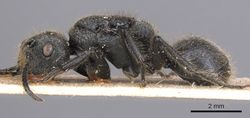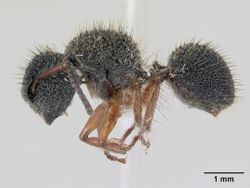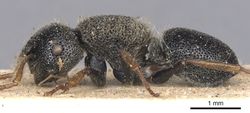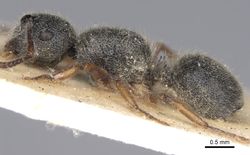Key to Echinopla species
This key to Echinopla workers is based on Xu & Zhou (2015[1]). This is the most current key to treat all the species in the genus, but there have been more than ten new species described since this was key published.
You may also be interested in
1
- In full-face view, frontal lobes very narrow and suberect, such that antennal fossae exposed (Fig. 1). In lateral view, petiole nearly square, not narrowed dorsally, as high as gaster (Fig. 9). In dorsal view, petiole roughly trapezoidal, narrowed posteriorly, sides without spines or teeth (Fig. 18). Body surface shagreened (Fig. 1, 9, 18), not longitudinally striate, bluntly spined nor densely cribrate. Body black; mandibles, antennae, eyes and legs blackish brown (Indonesia) …..Echinopla mistura
- In full-face view, frontal lobes laterally expanded, such that antennal fossae partly or completely concealed by frontal lobes (Figs. 2-8, 27-30, 39-46). In lateral view, petiole roughly conical, narrowed dorsally, much lower than gaster (Figs. 10-16, 31-34, 47-54). In dorsal view, petiole transverse, sides always spined or toothed (Figs. 19-25, 35-38, 58-65). Body surface more or less longitudinally striate (Figs. 19-26), bluntly spined (Figs. 35-38), or densely cribrate (Figs. 59-68), at least body sides densely cribrate (Fig. 47) .....2
2
return to couplet .....1
- Head or mesosoma longitudinally striate (Figs. 2-8, 19-26) .....3
- Head and mesosoma bluntly spined (Figs. 2730, 31-34) or densely cribrate (Figs. 40-46, 59-68), or at least body sides densely cribrate (Fig. 47) .....8
3
return to couplet .....2
- Propodeum irregularly rugose, not longitudinally striate (Figs. 19-21) .....4
- Propodeum regularly longitudinally striate (Figs. 22-26) .....5
4
return to couplet .....3
- In full-face view, frons of head irregularly rugose, not longitudinally striate (Figs. 2-3). In dorsal view, humeral corners of pronotum forming a right-angle. Petiole with a long spine on each side, distance between spine tips wider than propodeum (Fig. 19). Body black (Indonesia, Philippines, Sulawesi …..Echinopla vermiculata
- In full-face view, frons of head regularly longitudinally striate (Fig. 4). In dorsal view, humeral corners of pronotum bluntly angled. Petiole with a short spine on each side, distance between spine tips narrower than propodeum (Fig. 21). Body black (New Guinea, Philippines) …..Echinopla pseudostriata
5
return to couplet .....3
- Gaster smooth, without longitudinal striation. In dorsal view, humeral corners of pronotum roundly angled. Petiole with a short spine on each side, distance between spine tips narrower than propodeum (Fig. 22). Body black (Indonesia) …..Echinopla deceptor
- Gaster not smooth, longitudinally striate. In dorsal view, humeral corners of propodeum forming an obtuse or right angle. Petiole with a long spine on each side, distance between spine tips as wide as or wider than propodeum (Figs. 23-26) .....6
6
return to couplet .....5
- In dorsal view propodeum roughly rectangular, weakly widened posteriorly, anterior corners acutely toothed. Humeral corners of pronotum acutely toothed (Fig. 26). Body black (Borneo) …..Echinopla densistriata
- In dorsal view propodeum roughly trapezoidal, strongly widened posteriorly, anterior corners without acute teeth. Humeral corners of pronotum bluntly toothed (Figs. 23-25) .....7
7
return to couplet .....6
- In full-face view, head finely longitudinally striate, frons with about 70 striations between eyes (Fig. 6). Body dorsum with blackish standing hairs and sparse pubescence (Fig. 14, 23). Body black (Malaysia, Philippines, Borneo, Indonesia, China) …..Echinopla striata
- In full-face view, head coarsely longitudinally striate, frons with about 50 striations between eyes (Fig. 7-8). Body dorsum with whitish standing hairs and dense pubescence (Fig. 15-16, 24-25). Body black (Borneo, Indonesia, India, Nicobar Island, Krakatau Island) …..Echinopla lineata
8
return to couplet .....2
- Head and mesosoma bluntly spined with background retirugose (Figs. 27-38) .....9
- Head and mesosoma cribrate with interstice coarsely retirugose (Fig. 40-68), at least body sides densely cribrate (Fig. 47) .....12
9
return to couplet .....8
- In lateral view, dorsum of mesosoma strongly convex and forming a complete arch, not interrupted by impressed or notched metanotal groove (Figs. 31-32). In dorsal view, mesosoma slightly constricted at metanotal groove position (Figs. 35-36) .....10
- In lateral view, dorsum of mesosoma almost straight, not forming a complete arch, interrupted by impressed or notched metanotal groove (Figs. 33-34). In dorsal view, mesosoma strongly constricted at metanotal groove position (Figs. 37-38).....11
10
return to couplet .....9
- Dorsa of head, mesosoma and first gastral segment with well developed long blunt spines. Sides of head regularly longitudinally striate (Figs. 27, 31). In dorsal view each side of petiole with a long spine, longer than half the width of the node (Fig. 35). Body black; mandibular apices, last two segments of tarsi and gastral apex reddish brown; eyes blackish brown (Singapore, Malaysia, Borneo, Thailand) …..Echinopla melanarctos
- Dorsa of head and mesosoma with weakly developed short blunt spines, first gastral segment densely cribrate. Sides of head irregularly rugose (Fig. 28, 32). In dorsal view, each side of petiole with a short spine, shorter than half width of the node (Fig. 36). Body black; mandibles and antennae reddish brown; legs and gastral apex yellowish brown (Borneo, Philippines, Thailand) …..Echinopla pallipes
11
return to couplet .....9
- In full-face view, eyes moderately convex and barely break lateral outline of head (Fig. 29). In lateral view, dorsal outline of mesosoma interrupted by distinctly impressed metanotal groove (Fig. 33). Dorsa of head and mesosoma with moderately long blunt spines. Sides of first gastral segment longitudinally striate (Fig. 33, 37). Body black; mandibles and antennae reddish brown; legs and gastral apex yellowish brown; eyes blackish brown (Borneo, Indonesia) …..Echinopla tritschleri
- In full-face view, eyes strongly convex and distinctly break lateral outline of head (Fig. 30). In lateral view, dorsal outline of mesosoma indistinctly interrupted by narrowly notched metanotal groove (Fig. 34). Dorsa of head and mesosoma with short blunt spines. Sides of first gastral segment densely cribrate (Fig. 34, 38). Body black; mandibles and antennae reddish brown; legs yellowish brown (India, China) …..Echinopla cherapunjiensis
12
return to couplet .....8
- Dorsa of head and mesosoma smooth and shining (Figs. 39, 58), sides of mesosoma and gaster densely elongately cribrate (Fig. 47). In dorsal view, propodeum wider than pronotum (Fig. 58). Body dorsum hairless (Fig. 47). Body black; flagella, palpi and tarsi yellowish brown (Indonesia) …..Echinopla nitida
- Dorsa of head and mesosoma densely cribrate (Figs. 40-46, 59-68). In dorsal view, propodeum as wide as or narrower than pronotum (Figs. 59-68). Body dorsum with abundant hairs (Figs. 48-57) Body color not as above .....13
13
return to couplet .....12
- Cribrate holes of mesosoma oblongate, irregular and not circular. In dorsal view, posterior part of mesonotum with a tooth on each side. Queens (Figs. 59, 66) .....14
- Cribrate holes of mesosoma not oblongate, regular and circular. In dorsal view, posterior part of mesonotum without a tooth on each side. Workers (Figs. 60-65, 67-68) .....15
14
return to couplet .....13
- In lateral view, dorsum of mesonotum straight. Posterodorsal corner of propodeum broadly rounded (Fig. 48). In dorsal view lateral teeth of mesonotum blunt, located at sides of scutellum. Posterior margin of scutum and posterior margin of scutellum nearly straight (Fig. 59). Body black; mandibles reddish brown; ocelli and legs yellowish brown; eyes blackish brown (New Guinea) …..Echinopla silvestrii
 Echinopla silvestrii dealate queen |
- In lateral view, dorsum of mesonotum weakly convex. Posterodorsal corner of propodeum narrowly rounded (Fig. 55). In dorsal view lateral teeth of mesonotum acute, located at posterolateral corners of scutum. Posterior margin of scutum weakly concave, posterior margin of scutellum weakly convex (Fig. 66). Body black; antennae, tibiae and tarsi brown (New Guinea) …..Echinopla maeandrina
 Echinopla maeandrina dealate queen |
15
return to couplet .....13
- In lateral view, dorsal outline of mesosoma interrupted by impressed metanotal groove (Figs. 49-50) .....16
- In lateral view, dorsal outline of mesosoma entire, metanotal groove not impressed (Figs. 51-54, 56-57) .....18
16
return to couplet .....15
- In lateral view, metanotal groove deeply impressed (Fig. 49). In dorsal view, petiole with a long spine on each side. Gaster shining, sparsely finely cribrate, interstice 2-3 times puncture diameter (Fig. 60). Body black; mandibles, antennae, tibiae and tarsi blackish brown; palpi, femora and last two tarsal segments brownish yellow (Indonesia, Sulawesi) …..Echinopla dubitata
- In lateral view, metanotal groove weakly impressed (Fig. 50). In dorsal view, petiole with more than one spine or tooth on each side. Gaster not shining, densely finely cribrate, interstice about as wide as puncture diameter (Fig. 61) .....17
17
return to couplet .....16
- In dorsal view, petiole with four teeth on each side. Humeral corners of pronotum bluntly angled, anterior and lateral margins of promesonotum entire (Fig. 61). Body black; mandibles, antennae and legs brownish yellow; eyes and gastral apex yellowish brown (Australia, New Guinea) …..Echinopla australis
- In dorsal view, petiole with three stout spines on each side. Humeral corners of pronotum toothed, anterior and lateral margins of promesonotum weakly finely crenulate. Body black with bronze shimmer (Borneo) …..Echinopla rugosa
18
return to couplet .....13
- In dorsal view mesosoma strongly constricted between mesonotum and propodeum (Figs. 67, 68) .....19
- In dorsal view mesosoma weakly constricted between mesonotum and propodeum (Figs. 62-65) .....20
19
return to couplet .....18
- Metanotal groove present, but not impressed. Sides of promesonotum entire (Figs. 56, 67). Body black; antennae and legs reddish (New Guinea) …..Echinopla octodentata
- Metanotal groove absent. Sides of promesonotum serrate (Figs. 57, 68). Body black (New Guinea) …..Echinopla arfaki
20
return to couplet .....18
- In dorsal view, mesosoma slightly narrowed posteriorly, propodeum about as broad as pronotum (Figs. 62-63) .....21
- In dorsal view, mesosoma strongly narrowed posteriorly, propodeum distinctly narrower than pronotum (Figs. 64-65) .....22
21
return to couplet .....20
- In full-face view, head abundantly cribrate, punctures on head roughly circular, interstice smooth and shining, wider than punctures diameter (Fig. 43). In lateral view, dorsum of mesosoma weakly convex, dorsum of gaster lacking standing hairs and pubescence (Fig. 51). In dorsal view, gaster abundantly cribrate, interstice about as broad as puncture diameter (Fig. 62). Body black; mandibles and femora blackish brown; antennae, tibiae and tarsi brownish yellow (Indonesia) …..Echinopla praetexta
- In full-face view, head densely cribrate, punctures on head elongate elliptical, interstice dull, narrower than puncture diameter (Fig. 44). In lateral view, dorsum of mesosoma strongly convex, dorsum of gaster with abundant standing hairs and pubescence (Fig. 52). In dorsal view, gaster densely cribrate, interstice narrower than puncture diameter (Fig. 63). Body black; apices of mandibles and last tarsal segments blackish brown (New Guinea) …..Echinopla crenulata
22
return to couplet .....20
- In full-face view, head densely elongately cribrate, interstice much narrower than puncture diameter (Fig. 45). In lateral view, dorsum of mesosoma strongly convex, propodeal declivity steeply sloped. Dorsum of mesosoma with sparse standing hairs, dorsum of gaster without pubescence (Fig. 53). In dorsal view, gaster densely elliptically cribrate, interstice narrower than puncture diameter (Fig. 64). Body black; mandibles, antennae and legs brownish yellow (Indonesia) …..Echinopla serrata
- In full-face view, head densely circularly cribrate, interstice about as broad as puncture diameter (Fig. 46). In lateral view, dorsum of mesosoma weakly convex, propodeal declivity nearly vertical. Dorsum of mesosoma with abundant standing hairs, dorsum of gaster with dense pubescence (Fig. 54). In dorsal view, gaster densely finely cribrate, interstice about as broad as puncture diameter (Fig. 65). Body black; mandibles yellowish red; antennae and legs yellowish brown (Australia) …..Echinopla turneri
References
<References>






























































